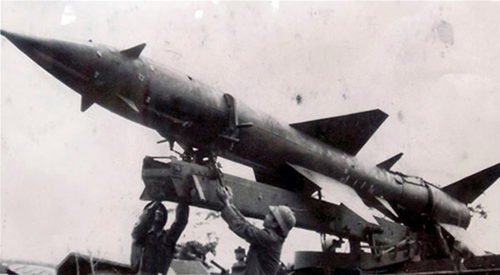By late November 1972, the military technical sector had given six sets of missile launch control stations and two lines of missile ammunition assembly; provided two missile launching vehicles, six sets of P-12 radars, eight gauges, 34 electric generators, 40 missile carriers, and 143 missiles. During the campaign, the Air Defense - Air Force Service transported 271 missiles from depots to combat units.
    |
 |
|
Air defense troops prepare the missile for combat missions in 1972. (A file photo) |
Although the active preparation had been carried out, the lack of anti-aircraft missiles remained because of the massive air raids of B-52 bombers of the U.S. Therefore, the air defense force was ordered to use the missiles sparingly to save them for attacking B-52s since the evening of December 18, 1972.
To avoid the lack of the missiles, the Air Defense - Air Force Service and its affiliated units collaborated with relevant sectors to mobilize all sources to implement the main mission.
In addition, the establishments for missile ammunition assembly enhanced their productivity. The missiles then were immediately transported to the battlefield. The units were also supplemented with fuel, wings, and other accessories to actively assemble the missiles.
In Hanoi, two assembly teams of Factory A31 were mobilized to inspect and repair the missiles for Division 361. The Technical Department of the Air Defense - Air Force Service transported 78 missiles to Division 361 and 27 missiles to Division 363. Also, missile ammunition reserves in Thanh Hoa were immediately transferred to supplement the battlefields in Hanoi.
One of the key tasks of the technical work was repairing and upgrading the launch pad, relevant equipment, and missiles. Numerous technical solutions were applied to promptly fix the slightly damaged equipment, contributing to serving the combat missions.
Thanks to the urgent and timely preparations, anti-aircraft missile and artillery units effectively destroyed many aircraft of the enemy, including the B-52s, in the Hanoi and Hai Phong's sky.
The Technical Department of the Air Defense - Air Force Service also directed affiliated units to send mobile fixing teams to the combat units to repair damaged technical devices and equipment.
Apart from ensuring technical support for the major units, the technical sector also gave assistance to the people’s air defense forces to protect Hanoi, Hai Phong and Thai Nguyen, including four companies of 100mm artillery, 721 anti-aircraft 14.5mm and 12.7mm machine guns, and more than 54,000 militiamen. The support of the military technical sector significantly contributed to the victory of the Hanoi - Hai Phong air defense campaign, and the “Hanoi - Dien Bien Phu in the air” victory in 1972.
Translated by Trung Thanh